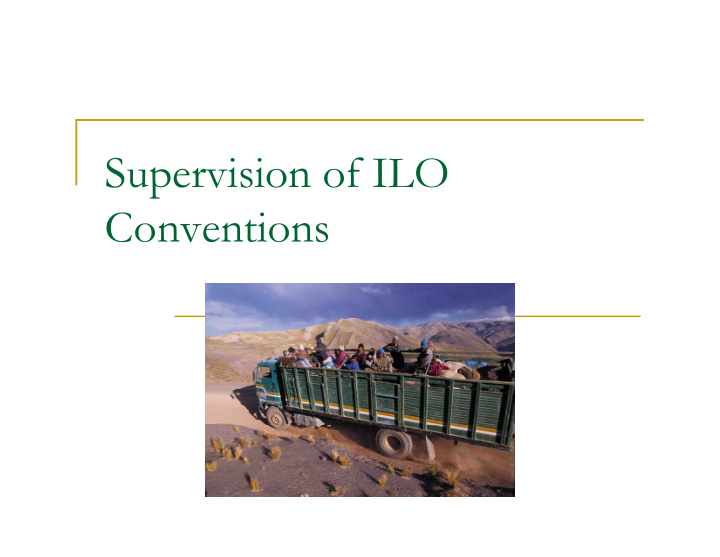



Supervision of ILO Conventions
The ILO supervisory system � Systematic mechanisms for examining the implementation of ratified ILO Conventions � Ongoing dialogue between Governments and the ILO � Can be complemented by technical cooperation
ILO Structure TRIPARTI TE Workers (trade unions) Governments Employers (1) (2) (1)
ILO Organs International Labour Conference International Labour Standards 182 Member States Governing Body 56 members International Labour Office Permanent Secretariat Research and documentation centre
International Labour Standards Conventions Recommendations � When ratified, these are legally � General or technical guidelines binding � Not open to ratification � If they are not ratified, they represent objectives and influence national legislation
Ratification � Formal registration � Comes into force 1 year later � Obligations to report: � 1 st report one year after a Convention comes into force � Periodic report every 1 to 5 years
Core ILO Conventions � 29 (Forced Labour) and 105 (Abolition of Forced Labour) � 138 (minimum Age) and 182 (Worst Forms of Child Labour) � 100 (Equal Remuneration) and 111 (Discrimination in Employment and Occupation) � 87 (Freedom of Association and Protection of the Right to Organize) and 98 (Right to Organize and Collective Bargaining)
Supervisory mechanisms: Regular supervision (Article 22, ILO Constitution) Government reports Employers' and workers' comments Committee of Experts on the Application of Conventions and Recommendations Direct requests Observations published in Report III (1A) International Labour Conference
Special procedures: Representations (Article 24 ILO Constitution) Employers' or workers' organization International Labour Office Governing Body Tripartite Committee Committee of Experts on the Application of Conventions and Recommendations
What is the role of indigenous peoples? � Indigenous peoples do not have a formal place within the ILO’s supervisory mechanisms � In order to access the supervisory system directly and “officially”, it is necessary to work with or through the ILO’s tripartite partners (most often workers’ organizations) � Indigenous organizations can send “verifiable information” directly to the ILO (laws, court decisions, etc.) � Information from UN agencies, projects and mechanisms can be taken into account by the supervisory mechanisms � Innovative approaches can also be found – e.g., Norway � Governments can develop official national mechanisms for the inclusion of indigenous peoples in research, and the implementation and monitoring of the Convention � Indigenous peoples can work directly with the ILO through technical cooperation
The role of technical cooperation � Reinforcing the arguments for the protection of the rights of indigenous peoples � Sensitization and capacity-building � Identification of implementation challenges � Response to comments of supervisory bodies � Facilitation of dialogue, improving coordination � Development of legislation, policies and programmes � Facilitating the establishment of mechanisms for implementation and monitoring � Engagement of partners in implementation
Recommend
More recommend